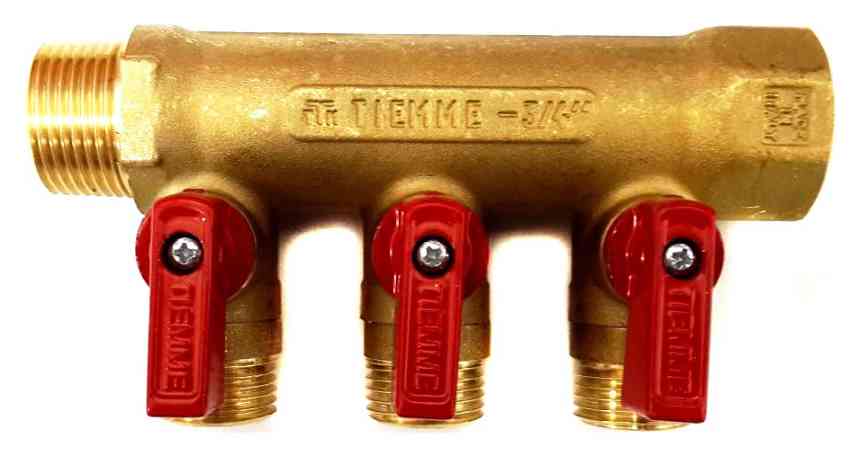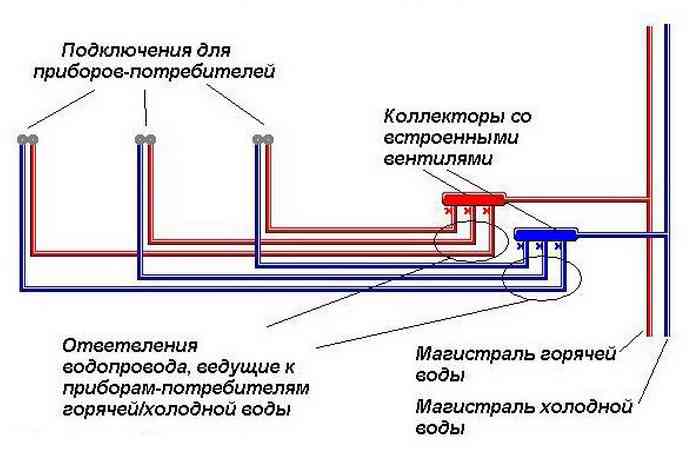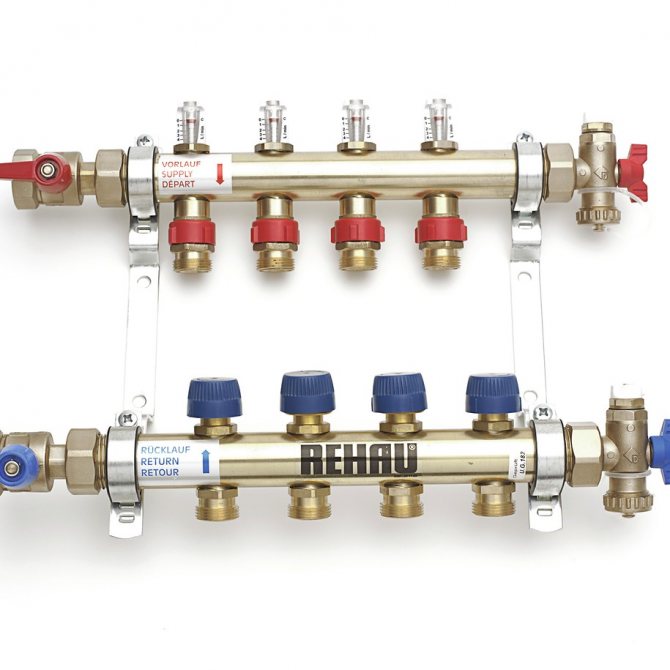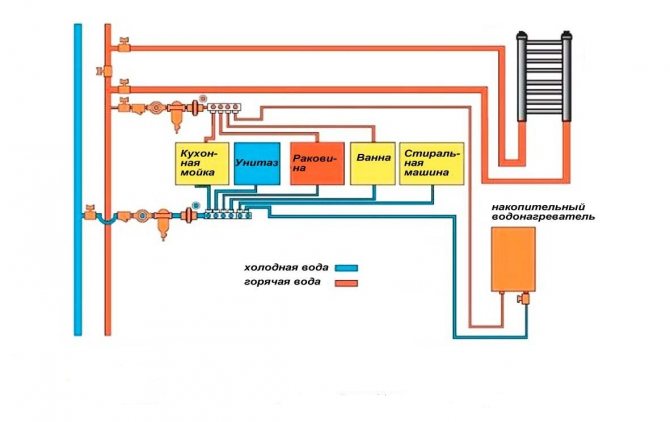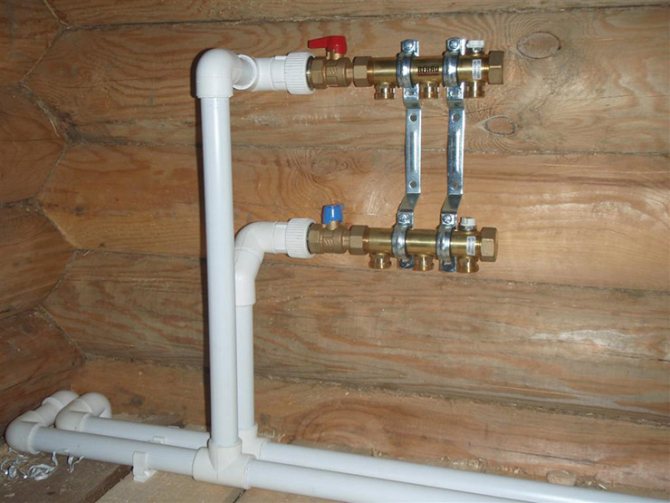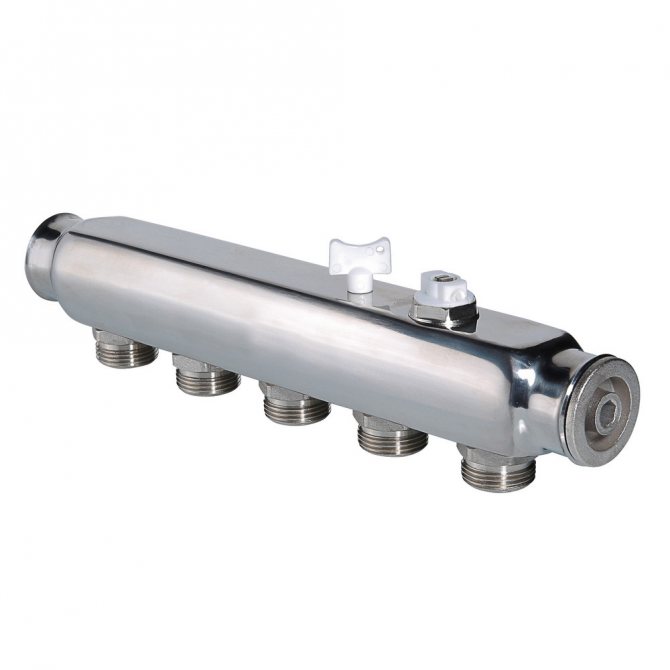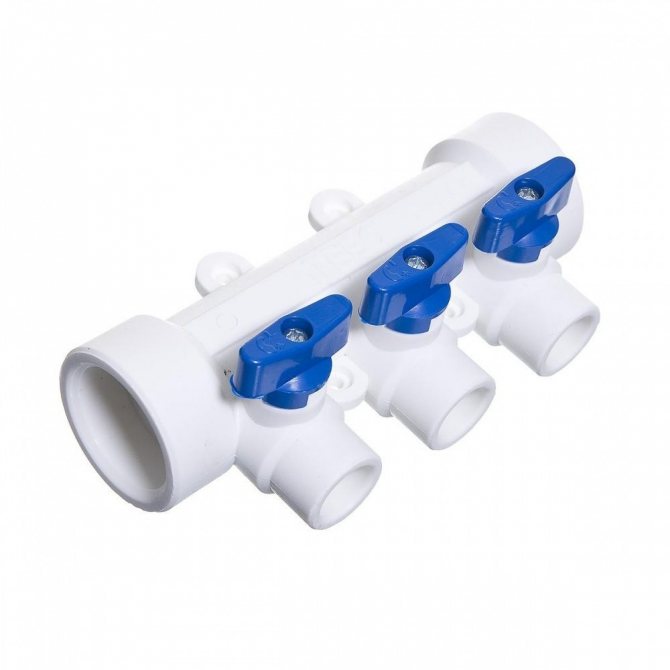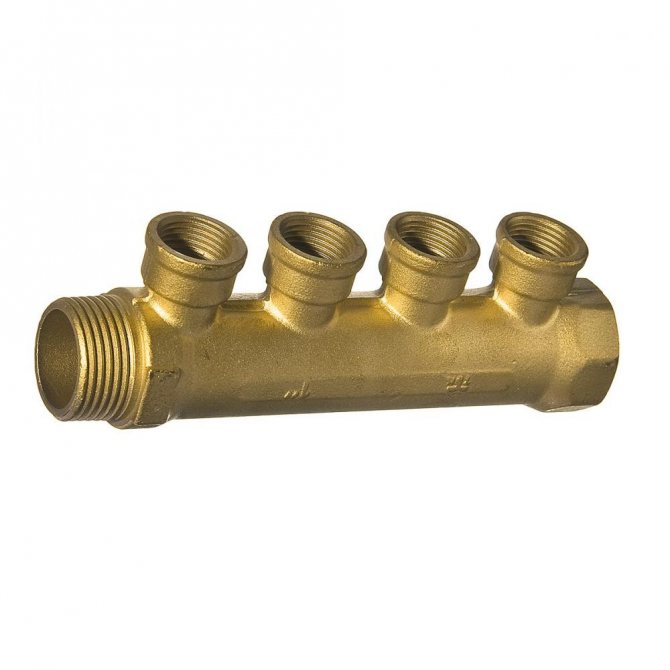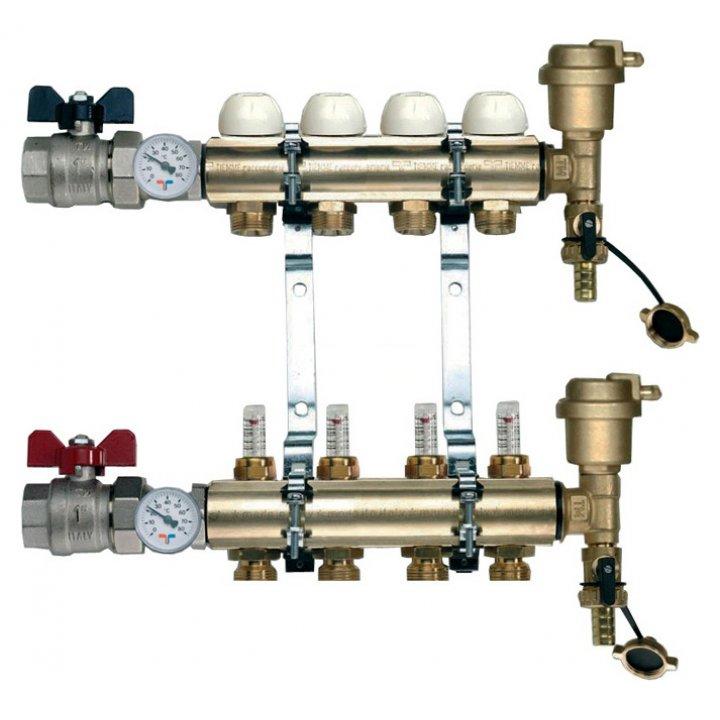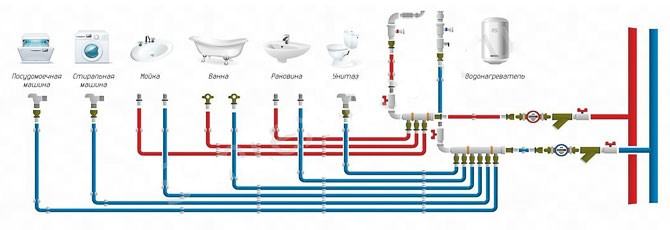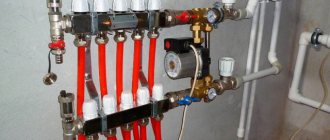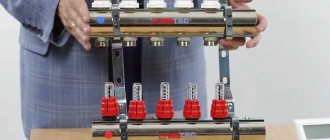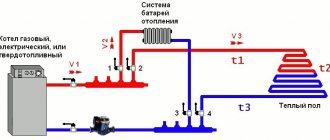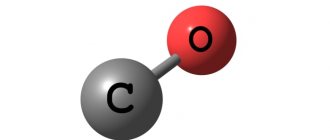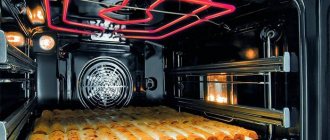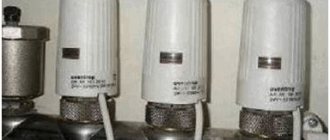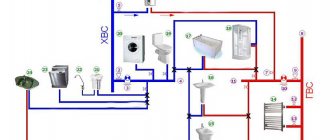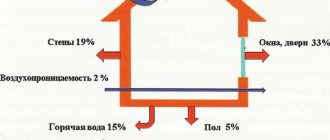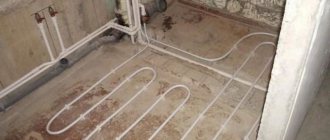The specifics of using solar collectors
The main feature of solar collectors, which distinguishes them from other types of heat generators, is the cyclical nature of their operation. No sun - no heat energy. As a result, such attitudes are passive at night.
Average daily heat production directly depends on the length of daylight hours. The latter is determined, firstly, by the geographical latitude of the area, and secondly, by the season. During the summer period, which is the peak of insolation in the Northern Hemisphere, the collector will work with maximum efficiency. In winter, its productivity falls, reaching a minimum in December-January.
In winter, the efficiency of solar collectors decreases not only due to a decrease in the duration of daylight hours, but also due to a change in the angle of incidence of sunlight. Fluctuations in solar collector performance throughout the year should be taken into account when calculating its contribution to the heat supply system.
Another factor that can affect the productivity of the solar collector is the climatic features of the region. On the territory of our country there are many places where the sun is hidden behind a thick layer of clouds or behind a veil of fog for 200 or more days a year. In cloudy weather, the performance of the solar collector does not drop to zero, since it is able to capture scattered sunlight, but it significantly decreases.
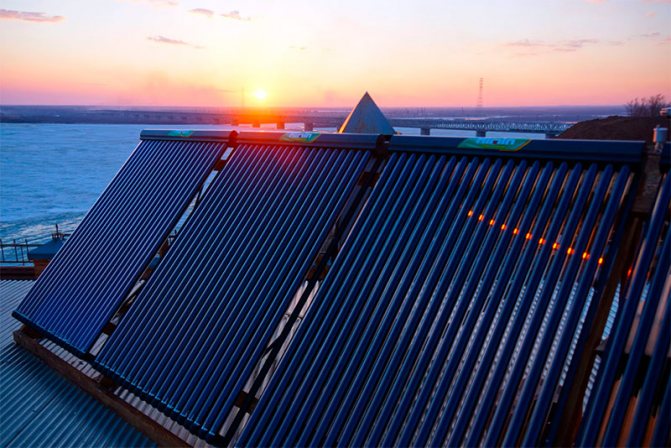
Collector water supply system
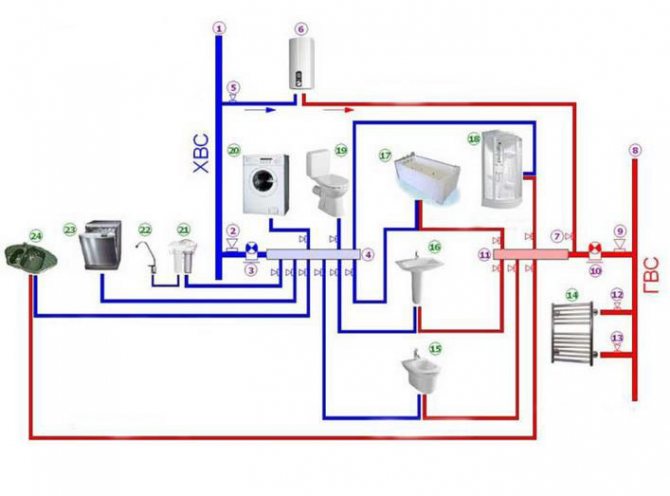

If a collector is included in the system, then whatever device is installed in the circuit, a separate branch will be laid to it. At the same time, the total length of the pipes increases, but the following positive aspects appear:
- At all points of the water intake there will always be a stable and equal pressure;
- When tapping into the collector outlet of the reducer in this branch, suitable for any plumbing fixture, you can adjust the pressure, and it will be different from the total value;
- Each cut-in between the collector and the water draw-off point is a single piece of pipe that can be secretly fixed in the floor, in the wall or in a wall niche;
- Any plumbing fixture can be turned off without stopping the entire cold water or hot water supply for repair or replacement.
Disadvantages of the collector circuit:
- Longer pipe lengths automatically increase the hydraulic resistance in the line;
- Due to the increase in the length of the line, the collector will not work in the mode of natural water circulation, which may affect the choice or change of the heating system;
- If it is impossible to make the pipe system secretly fixed in walls or niches, then a large accumulation of pipes can force to change the interior or even the design of the premises.
The principle of operation and types of solar collectors
Now is the time to say a few words about the structure and operation of the solar collector. The main element of its design is an adsorber, which is a copper plate with a pipe welded to it. Absorbing the heat of the sun's rays falling on it, the plate (and with it the pipe) heats up quickly. This heat is transferred to the liquid heat carrier circulating through the pipe, which, in turn, transports it further through the system.
The ability of the physical body to absorb or reflect the sun's rays depends primarily on the nature of its surface. For example, a mirror surface perfectly reflects light and heat, but a black one, on the contrary, absorbs. That is why a black coating is applied to the copper plate of the adsorber (the simplest option is black paint).
How the solar collector works
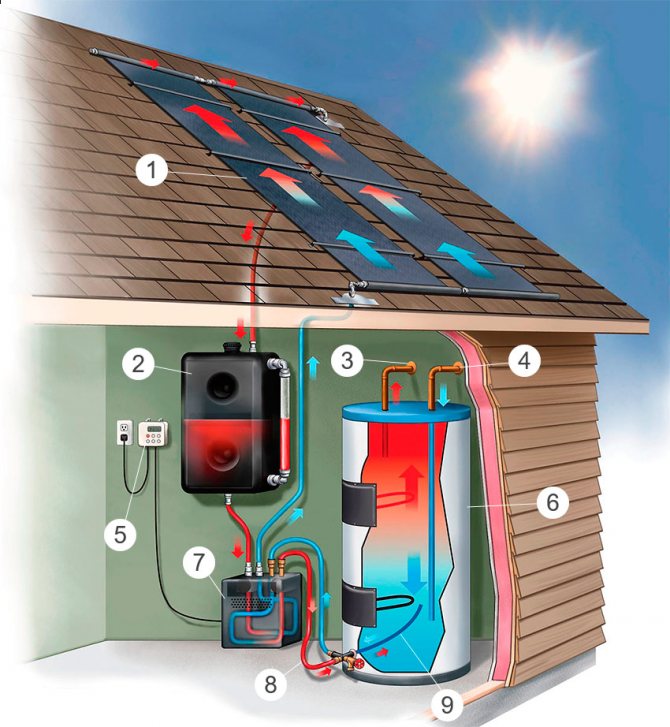

1. Solar collector. 2. Buffer tank. 3. Hot water.
4. Cold water. 5. Controller. 6. Heat exchanger.
7. Water pump. 8. Hot stream. 9. Cold stream.
It is also possible to increase the amount of heat received from the sun by choosing the correct glass covering the adsorber. Ordinary glass is not transparent enough. In addition, it glares, reflecting some of the incident sunlight. In solar collectors, as a rule, they try to use special glass with a low iron content, which increases its transparency. To reduce the proportion of light reflected by the surface, an anti-reflective coating is applied to the glass. And so that dust and moisture do not get inside the collector, which also reduce the throughput of the glass, the case is made sealed, and sometimes even filled with an inert gas.
Despite all these tricks, the efficiency of solar collectors is still far from 100%, which is due to the imperfection of their design. The heated adsorber plate radiates part of the received heat into the environment, heating the air in contact with it. To minimize heat loss, the adsorber must be insulated. The search for an effective way to insulate the adsorber led engineers to create several types of solar collectors, the most common of which are flat and tubular vacuum collectors.
Flat solar collectors
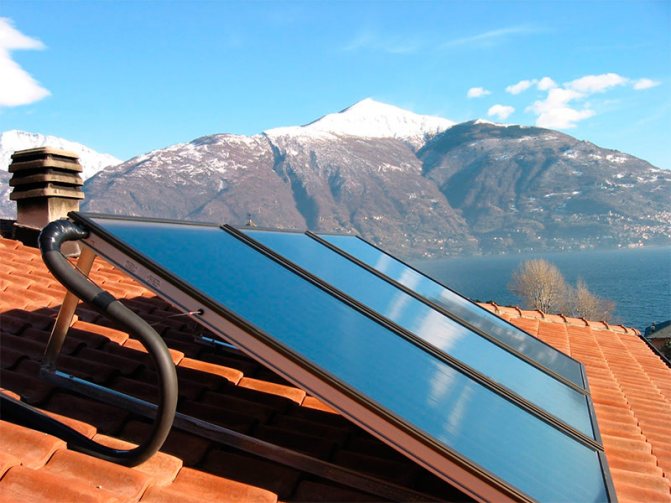

Flat solar collectors.
The design of a flat solar collector is extremely simple: it is a metal box covered with glass on top. As a rule, mineral wool is used for thermal insulation of the bottom and walls of the case. This option is far from ideal, since the transfer of heat from the adsorber to the glass by means of the air inside the box is not excluded. With a large temperature difference inside the collector and outside, heat losses are quite significant. As a result, a flat solar collector, which functions perfectly in spring and summer, becomes extremely ineffective in winter.
Flat solar collector device
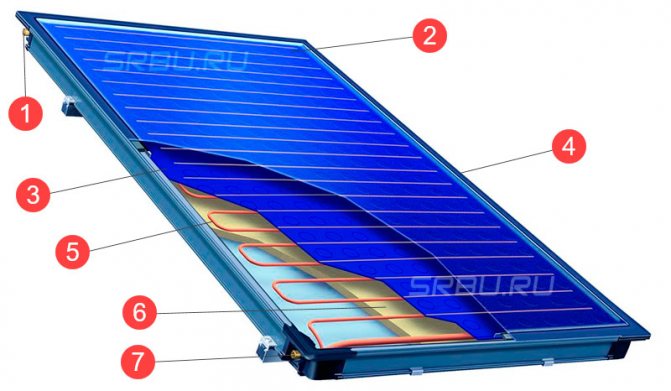

1. Inlet pipe. 2. Safety glass.
3. Absorption layer. 4. Aluminum frame.
5. Copper tubes. 6. Heat insulator. 7. Outlet pipe.
Tubular vacuum solar collectors
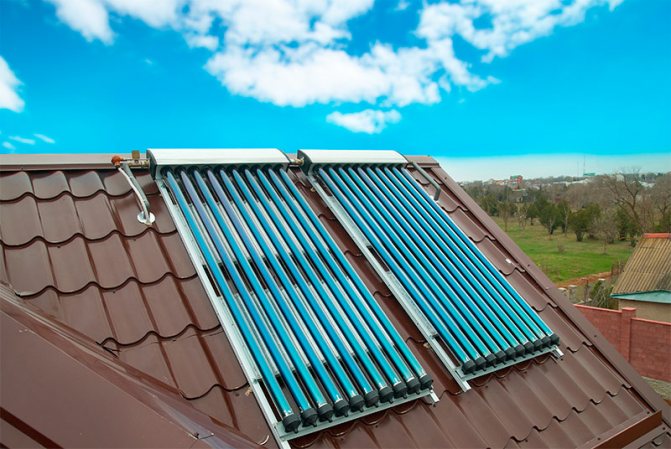

Tubular vacuum solar collectors.
A solar vacuum collector is a panel made up of a large number of relatively thin glass tubes. An adsorber is located inside each of them. To exclude the transfer of heat by gas (air), the tubes are evacuated. It is due to the absence of gas near the adsorbers that vacuum collectors are distinguished by low heat losses even in frosty weather.
Vacuum manifold device
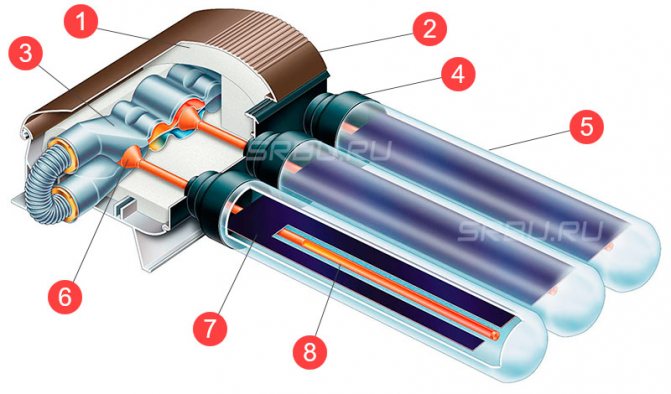

1. Thermal insulation. 2. Heat exchanger housing. 3. Heat exchanger (collector)
4. Sealed plug. 5. Vacuum tube. 6. Capacitor.
7. Absorbing plate. 8. Heat pipe with working fluid.
Applications of solar collectors
The main purpose of solar collectors, like any other heat generators, is to heat buildings and prepare water for a hot water supply system. It remains to find out which type of solar collectors is best suited to perform a particular function.
Flat solar collectors, as we found out, have good performance in the spring and summer, but are ineffective in winter. From this it follows that using them for heating, the need for which appears precisely with the onset of cold weather, is impractical. This, however, does not mean that there is no business at all for this equipment.
Flat collectors have one indisputable advantage - they are significantly cheaper than vacuum models, so in those cases when it is planned to use solar energy exclusively in the summer, it makes sense to purchase them.Flat solar collectors perfectly cope with the task of preparing water for hot water supply in the summer. Even more often they are used to warm water to a comfortable temperature in outdoor pools.
Tubular vacuum manifolds are more versatile. With the arrival of winter cold, their performance does not decrease as much as in the case of flat models, which means that they can be used all year round. This makes it possible to use such solar collectors not only for hot water supply, but also in the heating system.
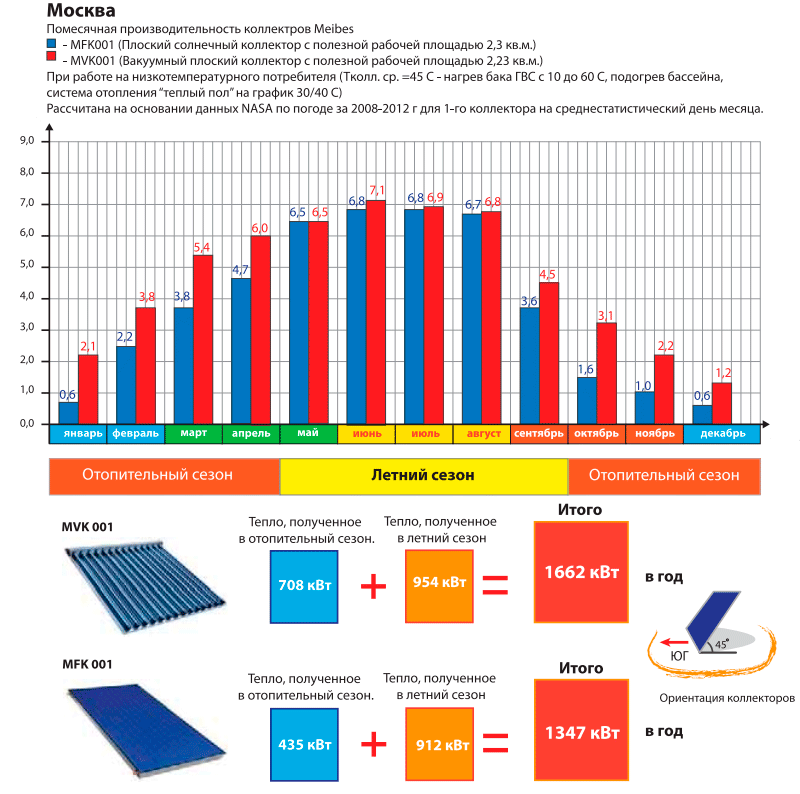

Comparison of flat and vacuum solar collectors.
Cost of equipment
Many homeowners are mistaken in the belief that a boiler room manifold is worth fabulous money. In plumbing stores you can find many models without any bells and whistles, which will cost only 200-500 rubles. Such equipment will not have regulation mechanisms, thermal heads and other additional elements, and they are designed for a maximum of 2-3 circuits.
Models with extended functionality will cost the owner of a house or industrial building who wants to organize a competent heating system, approximately 4-5 thousand rubles. A long pipe with several top and bottom outlets will be complete with thermal heads, flow meters, arrows and other parts. Such structures are often produced by Russian manufacturers or trade marks of neighboring countries. The most expensive is imported equipment with automatic adjustment, which will cost 10-16 thousand rubles.
Arrangement of solar collectors
The efficiency of a solar collector directly depends on the amount of sunlight falling on the adsorber. It follows from this that the collector should be located in an open space, where a shadow from neighboring buildings, trees located near mountains, etc. never falls (or at least for the longest time).
It is not only the location of the collector that matters, but also its orientation. The most "sunny" side in our northern hemisphere is the southern one, which means that ideally the "mirrors" of the reservoir should be turned strictly to the south. If it is technically impossible to do this, then you should choose the direction as close as possible to the south - southwest or southeast.
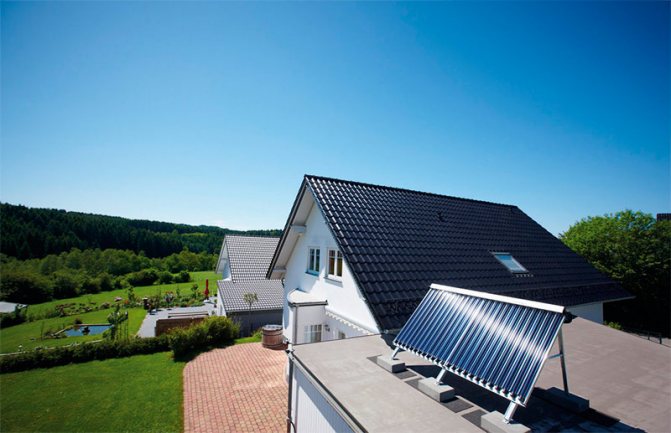

One should not lose sight of such a parameter as the angle of inclination of the solar collector. The value of the angle depends on the deviation of the position of the Sun from the zenith, which in turn is determined by the latitude of the area in which the equipment will be operated. If the angle of inclination is not set correctly, then the optical energy loss will increase significantly, since a significant part of the sunlight will be reflected from the collector glass and, therefore, will not reach the absorber.
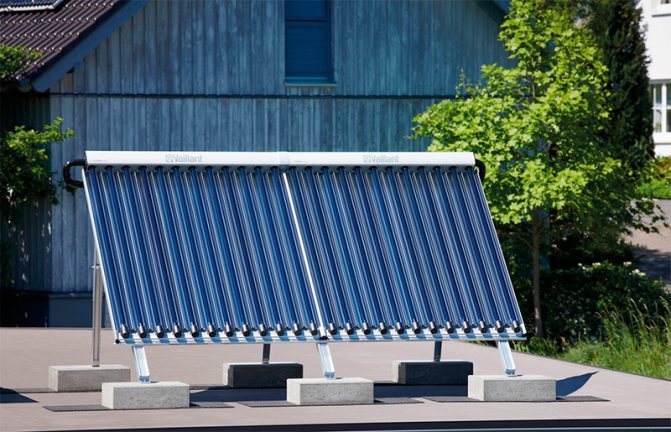

Excitation windings
The DC generator device has the potential to be used only in small electrical machines. First of all, because for low-power devices, the use of permanent magnets is permissible. In other cases, only solenoids - coils with a core - or excitation windings can create a magnetic flux of sufficient strength. By the type of food they eat generators can be divided into the following classes:
- with independent excitement;
- self-excited.
For the first operation, an auxiliary current source is required. This is the main disadvantage of this type of machine, so their use is limited. In generators with independent excitation, the windings are powered from the armature. Electric machines arranged according to this scheme, are divided in turn into three types:
- shunt (with parallel excitation);
- serial (with serial);
- compound generators (with parallel and series excitation coils).
How to choose a solar collector of the right power
If you want the heating system of your home to cope with the task of maintaining a comfortable temperature in the premises, and hot, not lukewarm water flowed from the taps, and at the same time plan to use a solar collector as a heat generator, you need to calculate the required equipment power in advance.
At the same time, it will be necessary to take into account a fairly large number of parameters, including the purpose of the collector (hot water supply, heating or their combination), the object's heat demand (total area of heated rooms or average daily hot water consumption), climatic features of the region, features of the collector installation.
In principle, making such calculations is not so difficult. The performance of each model is known, which means that you can easily estimate the number of collectors required to provide the house with heat. Companies engaged in the production of solar collectors have information (and can provide it to the consumer) about the change in the power of the equipment depending on the geographical latitude of the area, the angle of inclination of the "mirrors", the deviation of their orientation from the south direction, etc., which makes it possible to make the necessary corrections when calculating the performance of the collector.
When selecting the required collector capacity, it is very important to achieve a balance between lack and excess of generated heat. Experts recommend focusing on the maximum possible collector capacity, that is, using the indicator for the most productive summer season in the calculations. This goes against the desire of the average user to take equipment with a margin (that is, to calculate by the power of the coldest month), so that the heat from the collector is enough even on less sunny autumn and winter days.
However, if you choose a solar collector with increased power, then at the peak of its performance, that is, in warm sunny weather, you will face a serious problem: more heat will be produced than consumed, and this threatens overheating of the circuit and other unpleasant consequences ... There are two options for solving this problem: either install a low-power solar collector and connect backup heat sources in parallel in winter, or purchase a model with a large power reserve and provide for ways to discharge excess heat in the spring-summer season.
Features of the
The distribution manifold in the water supply network allows you to autonomously connect a number of devices to one input. Moreover, each device has a personal connection, and the water jet is cut off directly in the collector tube.
In addition to the fact that the presence of a distributor allows you to turn off the water supply for one or several plumbing units in an apartment from one point, such a scheme is convenient in social buildings, shopping centers or hotels: if somewhere flows, blocking the flow of water in the corresponding pipeline is possible even without access to the premises where the incident occurred.
Disadvantages of water supply through the manifold:
- The length of the water pipes used will be several times longer than with the traditional scheme, which will increase the cost of installation.
- Pipes cannot be placed in the wall, respectively, the structure will take up space and reduce the usable area, and this is a problem for small apartments or non-residential premises.
System stagnation
Let's talk a little more about the problems associated with an excess of generated heat. So, let's say that you have installed a sufficiently powerful solar collector that can fully provide heat to the heating system of your home. But summer has come, and the need for heating has disappeared. If you can turn off the power supply for an electric boiler, or cut off the fuel supply for a gas boiler, then we have no power over the sun - we cannot “turn it off” when it gets too hot.
System stagnation is one of the major potential problems for solar collectors. If not enough heat is taken from the collector circuit, the coolant overheats. At a certain moment, the latter can boil, which will lead to the termination of its circulation along the circuit. When the coolant cools down and condenses, the system will resume operation. However, not all types of heat transfer fluids calmly transfer the transition from a liquid to a gaseous state and vice versa. Some, as a result of overheating, acquire a jelly-like consistency, which makes further operation of the circuit impossible.
Only a stable removal of the heat produced by the collector will help to avoid stagnation. If the calculation of the power of the equipment is made correctly, the probability of problems is practically zero.
However, even in this case, the occurrence of force majeure is not excluded, therefore, methods of protection against overheating should be foreseen in advance:
1. Installation of a reserve tank for accumulating hot water. If the water in the main tank of the hot water supply system has reached the set maximum, and the solar collector continues to supply heat, it will automatically switch over, and the water will begin to heat up already in the reserve tank. The created supply of warm water can be used for domestic needs later, in cloudy weather.
2. Heated pool water. Owners of houses with a swimming pool (whether indoor or outdoor) have an excellent opportunity to remove excess heat energy. The volume of the pool is incomparably greater than the volume of any household storage, which means that the water in it will not heat up so much that it will no longer be able to absorb heat.
3. Draining hot water. In the absence of the opportunity to spend excess heat usefully, you can simply drain the heated water in small portions from the storage tank for hot water supply into the sewer. The cold water entering the container will lower the temperature of the entire volume, which will continue to remove heat from the circuit.
4. External heat exchanger with fan. If the solar collector has a large capacity, the excess heat can also be very large. In this case, the system is equipped with an additional circuit filled with refrigerant. This additional circuit is connected to the system by means of a heat exchanger equipped with a fan and mounted outside the building. If there is a risk of overheating, excess heat enters the additional circuit and is "thrown" into the air through the heat exchanger.
5. Discharge of heat into the ground. If, in addition to the solar collector, the house has a ground source heat pump, the excess heat can be directed into the well. At the same time, you solve two problems at once: on the one hand, you protect the collector circuit from overheating, on the other, you restore the heat reserve in the ground that has been depleted during the winter.
6. Isolation of the solar collector from direct sunlight. From a technical point of view, this method is one of the simplest. Of course, it's not worth climbing onto the roof and covering the collector manually - it's hard and unsafe. It is much more rational to install a remotely controlled shutter, like a roller shutter. You can even connect the damper control unit to the controller - in case of a dangerous increase in temperature in the circuit, the manifold will close automatically.
7. Draining the coolant. This method can be considered cardinal, but at the same time it is quite simple. If there is a risk of overheating, the coolant is drained by means of a pump into a special tank integrated into the system circuit. When conditions become favorable again, the pump will return the coolant to the circuit, and the collector will be restored.
Installing the manifold block
Heating collector installation is carried out in close proximity to the boiler... Radiator pipes from the heater are often laid along the floor, after which the structure is concreted and insulated, which minimizes heat loss. The collector block itself is mounted in a specially prepared shield or wall niche. A special shield can be hinged or built-in, complete with a door and side stamping, or open. If there is no possibility of mounting the cabinet, then the manifold block is fixed on the wall at a low height from the floor.
If the building is multi-storey, then the distributor will be installed on each floor of the house, which will allow heating any room. Such a system will allow you to regulate, connect and disconnect one or more heating radiators, the entire room, a full circuit. This eliminates the need to turn off the coolant supply to other heating sources. Storerooms, hallways, corridors, wardrobes are used as premises for installing the distribution manifold.
Other system components
It is not enough to simply collect the heat radiated from the sun. It still needs to be transported, accumulated, transferred to consumers, all these processes need to be monitored, etc. This means that in addition to the collectors located on the roof, the system contains many other components, which may be less noticeable, but no less important. Let's focus on just a few of them.
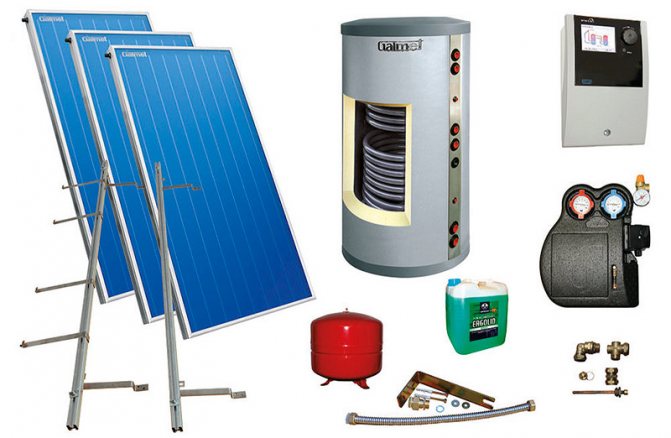

Heat carrier
The function of the coolant in the collector circuit can be performed either by water or by an anti-freeze liquid.
Water has a number of disadvantages that impose certain restrictions on its use as a coolant in solar collectors:
- First, at negative temperatures, it solidifies. To prevent the frozen coolant from bursting the pipes of the circuit, with the approach of cold weather it will have to be drained, which means that in winter you will not receive even small amounts of thermal energy from the collector.
- Secondly, a not too high boiling point of water can cause frequent stagnation in the summer.
Non-freezing liquid, unlike water, has a significantly lower freezing point and incomparably higher boiling point, which increases the convenience of using it as a heat carrier. However, at high temperatures, "non-freezing" can undergo irreversible changes, so it should be protected from excessive overheating.
Pump adapted for solar systems
To ensure the forced circulation of the coolant along the collector circuit, a pump adapted for solar systems is required.
DHW heat exchanger
Heat is transferred from the solar collector circuit to the hot water supply or to the heating medium of the heating system by means of a heat exchanger. As a rule, a large-volume tank with a built-in heat exchanger is used to accumulate hot water. It is rational to use tanks with two or more heat exchangers: this will allow taking heat not only from the solar collector, but also from other sources (gas or electric boiler, heat pump, etc.).
Classic wiring diagram
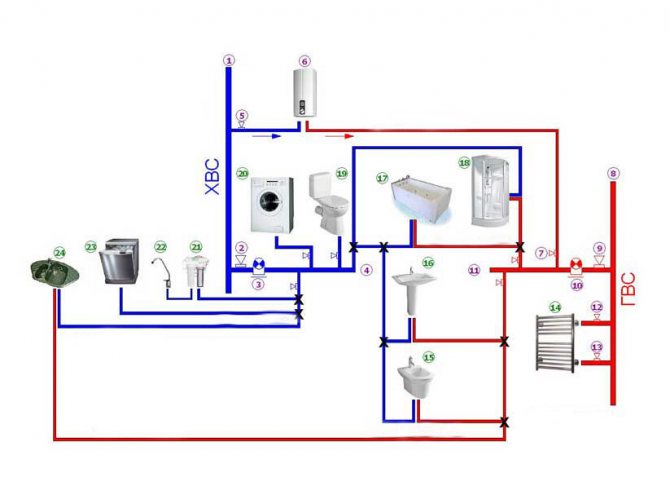

The usual wiring diagram for water supply pipes around the house is tee or sequential: a pipeline is diverted from the main riser, to which the necessary devices and equipment are connected through tees and taps.
This connection technology is beneficial in the following points:
- Minimum total pipe length;
- Low hydraulic resistance in the water supply system.
In practice, this scheme has not proven itself from the best side - it turned out that it is better to implement a connection via a comb. The disadvantage of the traditional connection is that when several valves are opened at the same time, the pressure in one of them, or in both, drops.

